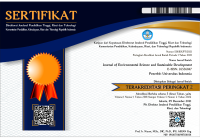Author ORCID Identifier
Author ORCID IDs
Nor Isnaeni Dwi Arista https://orcid.org/0000-0001-7196-2838
Ani Kurniawati https://orcid.org/0000-0003-2231-0694
Sandra Arifin Aziz https://orcid.org/0000-0002-5561-5227
Article Classification
Environmental Science
Abstract
The examination of sustainability within the textile industry necessitates an exploration of various environmental pollution issues. This study aims to tackle challenges in the synthetic dye industry by reviewing past research on textile dyeing, providing scientific insights, identifying patterns, and highlighting research gaps. It is hypothesized that the cultivation of Indigofera tinctoria with optimized NPK fertilization can significantly enhance its growth and yield, contributing to sustainable natural dye production. Using a mixed-methods approach, this study integrated bibliometric analysis of 1320 Scopus articles with field experiments. The bibliometric analysis, conducted with Vos Viewer software, identifies India and the United States as leaders in textile dye research. Key terms include indigo, indigo carmine, I. tinctoria, and natural dyes. A significant research gap is identified in the cultivation of I. tinctoria, particularly concerning the application of NPK (16:16:16) fertilization. Field experiments analyzed using R-studio demonstrate that NPK significantly increases the fresh weight of I. tinctoria at 11 weeks after planting. Pearson correlation analysis showed a significant correlation between the fresh weight of I. tinctoria on the dry weight of the plants (0.91***) and specific leaf weight (0.60*). These results indicate that advancing research on natural dye indigotin and the cultivation of I. tinctoria plants in the field is highly relevant to addressing research questions concerning the development of natural dye research and the cultivation methods of indigo dye plants in field conditions. NPK fertilization enhances the growth and yield of I. tinctoria, supporting sustainable cultivation in Indonesia. This research contributes to present a viable strategy for promoting sustainable natural dye production and addressing the identified research gap in the cultivation of this important dye-producing species. Future research should focus on optimizing NPK fertilization strategies to maximize yield and sustainability.
Recommended Citation
Arista, Nor Isnaeni Dwi; Aziz, Sandra Arifin; and Kurniawati, Ani
(2024).
NATURAL DYE OF INDIGOFERA TINCTORIA FOR TEXTILE INDUSTRY.
Journal of Environmental Science and Sustainable Development, 7(1), 578-598.
Available at: https://doi.org/10.7454/jessd.v7i1.1249





